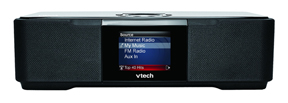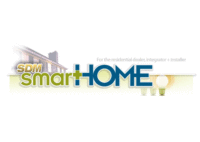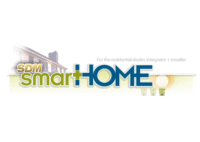
Graphic processing units such as this one from Nvidia feature advanced audio and video technologies that make them ideal for home theater PCs.
What do Lady Gaga, Harry Potter, Frank Sinatra and The Daily Show have in common? They all are content that can reside on external or at-home servers and be streamed to whole house audio, video and home theater systems.
Home entertainment has evolved into a systems opportunity that transcends typical home theater, intercom and speaker setups thanks to myriad technology advances. Home area networks have become more robust. Media players have turned into media servers. Most homeowners have broadband through cable, DLS or satellite. Network attached storage devices (NAS) are inexpensive and home NAS and video server devices can go from wimpy megabytes to scores of terabytes. There now are wired and wireless options; some already work with home automation controls, while others are better at handling formerly pipe-choking video data. And there is a growing array of music and video streaming services through the Web.
No doubt, this arena has a certain level of do-it-yourself. However, multi-room audio and video, enhanced home area networking, speakers and placement, racks of servers and NAS devices, as well as knowledge of what’s available as audio and video content on the Web, all come together to highlight the complexities of design and installation. And the need for professional help.
Earlier this month, the Custom Electronic Design & Installation Association (CEDIA) unveiled its first-ever Future Technology Pavilion, which will be featured at its annual CEDIA EXPO Sept. 22–26 in Atlanta. The pavilion will showcase emerging trends and cutting-edge home technologies that are expected to impact the electronic systems industry as homeowners transition to a digital lifestyle – through their television, computer and other multimedia components.
Each segment of the pavilion will feature technologies that represent a particular trend in the future of residential electronic systems. And one segment in the pavilion will spotlight the future of entertainment, home theaters and entertainment centers with a look at the integration of 3D, 9.1 surround sound and motion seating including state-of-art acoustic and video calibration to show an immersive experience in a residential environment.

Total music hubs for the home offer dynamic sound quality, ability to stream music from thousands of Internet radio stations, computers and digital audio players. Photo courtesy VTech
Home Audio Streaming
Whole house audio has been an offering from electronic systems contractors and dealers for many years. And some tech sources have been around as long.For example, NuVo Whole Home Audio of Hebron, Ky., has a stable of solutions including music servers and wireless synching devices linked to a homeowner’s PCs at various price points. Russound of Newmarket, N.H., takes a whole house entertainment systems approach with a smart media console built on a Windows Media Center platform. Both firms work with dealers and have technology to integrate into handhelds, streaming and iTunes media.
A newer whole home audio face is the CasaTunes Music Server with advanced multi-streaming capabilities, including up to five streams of Windows, iTunes, and iPod music as well as Internet radio with support for six or 12 output zones. Unlike some other music servers, Fort Collins, Colo.-based CasaTunes includes a hardware-based multi-zone switch providing the capability to switch any stream to one or more rooms, with individual volume level and equalization setting adjustments for each room. Using hardware to perform the switching ensures that all rooms, which share the same stream, are perfectly synchronized, with no annoying delays or echoes, according to chief executive officer David Krinker.
The technology can integrate with other vendor gear and works with Internet radio services ShoutCast and Radio Time so that dad can listen to polka music from Poland and daughter can listen to electronic dance music from a German station.
“But, for the most part, people are interested in listening to their own music, what they have ripped,” says Krinker, who points out the PC-friendly nature of the approach, which can access personal media libraries. Control can be through a regular Internet browser or even through in-wall displays.
Other sources of room-to-room audio include the Santa Barbara, Calif.-based Sonos multi-room music system and Cisco Linksys' wireless home audio system, both sold through retail and dealer channels.
Another PC-based example: Software Development Solutions’ Jamcast streaming media software (www.sdstechnologies.com) enables homeowners to send digital audio from any source directly to their favorite devices. Its virtual soundcard feature captures any audio playing on a home PC and then transmits it over the home wireless network to Digital Living Network Alliance (DLNA) and universal plug and play (UPnP) devices, such as gaming consoles, HDTVs, smartphones, media adapters, home theatre components and other popular connected devices in the home and beyond.
DLNA is a non-profit collaborative trade organization comprising more than 250 member companies in the mobile, consumer electronics, PC, and service provider industries. Alliance members have the common goal of using standards-based technology to make it easier for consumers to use, share and enjoy their digital photos, music and videos. As of May 2010, more than 7,000 different devices had obtained DLNA certified status, confirming interoperability with other devices.
UPnP is a set of networking protocols to allow devices to connect seamlessly and to simplify the implementation of home data sharing, communications, and entertainment. UPnP devices are "plug-and-play" in that when connected to a network they automatically announce their network address and supported device and services types.
Products such as Jamcast work with streaming services such as Pandora and Spotify and access music stored on a PC or NAS devices.

Netgear’s High-Performance Wireless-N HD Home Theater Kit is a carrier-grade solution for wirelessly playing multiple jitter-free 1080p HD video and audio streams to every room in the house. The Universal WiFi Internet Adapter for Home Theater Devices and Gaming Consoles delivers Wireless-N performance of up to 300 Mbps through the Ethernet port.
Photo courtesy of Netgear
Photo courtesy of Netgear
Home Video Streaming
Home video streaming is another kettle of fish.A home theater PC (HTPC) or media center is a convergence device that combines some or all the capabilities of a personal computer with a software application that supports video, photo, and music playback, and sometimes digital video recorder functionality. In recent years, other types of consumer electronics, including gaming systems and dedicated media devices, have crossed over to manage video and music content. The term "media center" also refers to specialized application software designed to run on a standard personal computer.
An HTPC and other convergence devices integrate many or all components of a home theater into a single unit co-located with a home entertainment system. An HTPC can come pre-configured with the required hardware and software needed to add television programming to the PC, or can be built from components.
For instance, the D-Link MediaLounge media player streams digital music, photos, slideshows, and videos stored on a network-enabled PC to the home entertainment center or home theater. The unit bridges the gap between digital media content and home entertainment center through a wireless 802.11g or wired 10/100 Ethernet network. It can also access media stored on a NAS device.
Interfacing and in-home transmission are more intense with video, of course.
HDMI or high-definition multimedia interface is a compact audio/video interface for transmitting uncompressed digital data. It represents a digital alternative to consumer analog standards, such as radio frequency coaxial cable, composite video, S-Video, SCART, component video, D-Terminal, or VGA. HDMI connects digital audio/video sources — such as set-top boxes, up-convert DVD players, HD DVD players, Blu-ray disc players, advanced video coding high definition or AVCHD camcorders, personal computers, video game consoles such as the PlayStation 3 and Xbox 360, and audio/video receivers — to compatible digital audio devices, computer monitors, and digital televisions. HDMI supports, on a single cable, any uncompressed TV or PC video format, including standard, enhanced, and high-definition video. The consumer electronics control or CEC allows HDMI devices to control each other when necessary and allows the user to operate multiple devices with one remote control handset.
“Video is the hardest nut to crack. It must be a clean, consistent signal. When bandwidth drops, you can really notice it,” adds Bill Rose, principal with WJR Consulting and a long-time consumer electronics veteran. He sees value in FireWire. “It is designed to stream in real-time, a guaranteed delivery.”
The IEEE 1394 interface, what Apple calls FireWire, is a serial bus interface standard for high-speed communications and isochronous real-time data transfer, frequently used by personal computers, as well as with digital audio and digital video. The interface is also known as i.LINK (Sony) and Lynx (Texas Instruments). IEEE 1394 replaced parallel SCSI in many applications because of lower implementation costs and a simplified, more adaptable cabling system. IEEE 1394 was adopted as the High-Definition Audio-Video Network Alliance (HANA) standard connection interface for audio/visual component communication and control. It’s also available in wireless, fiber optic, and coaxial versions using the isochronous protocols.
Overall, when it comes to wireless for audio and, especially video in the home, Rose advises electronic systems contractors that “there is no one solution. There are differences among the technologies themselves as well as differences in rooms, equipment placement, walls and other features in each home. Of course, the customer couldn’t care less what approach is taken.” But the dealer must know which ones are operable in a given situation. “You have to avoid the ‘almost operable’ approach,” Rose says.
Whatever the transmission method, no matter the types of PCs and servers, there is no doubt that streaming video into the home will grow, probably bigger than audio.
One reason to expect more growth into the home and onto mobile devices is Best Buy’s recently introduced CinemaNow, which offers on-demand video content including movies and TV shows on Blu-ray players and home theater systems. The service works via software developed by Sonic Solutions, and embeds in the hardware sold by Best Buy.
The digital video-on-demand market has grown at a tremendous pace in the past few years, fueled by increasing broadband penetration, higher broadband speeds and the emergence of new online business models from companies like Netflix, Apple TV, Comcast and Time Warner.
Even chip advances are going with the flow. One example: Data conversion and signal conditioning technology giant Analog Devices briefed smartHOME online about its new product, the industry's smallest, lowest power HDMI v1.4 transmit IC with integrated de-interlacer and on-chip CEC. It enables small, low-cost multimedia devices to provide high definition video performance and easy connectivity. Chris Chipman of ADI points out that such home technology aims to capture, display and share video, which is the sweet spot for audio/video savvy electronic systems contractors.




